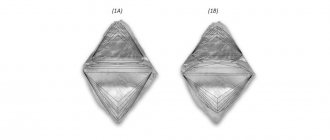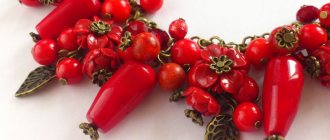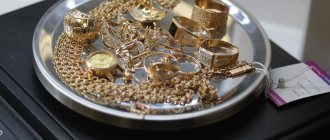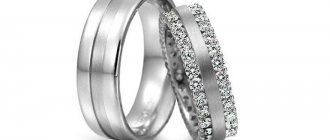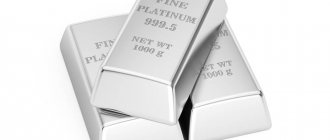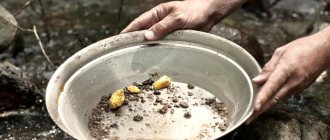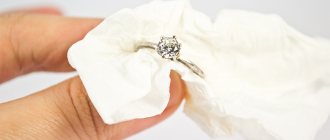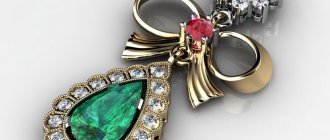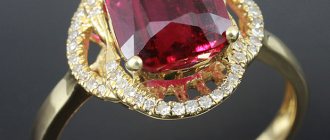The tradition of decorating oneself with jewelry goes back to ancient times. Archaeologists find confirmation of this during excavations in different parts of the world. At different times, both men and women decorated themselves, their suits and shoes.
Jewelry making has become a profession, jewelry has become a work of art. The number of jewelry that a woman decorates herself with at a time depends on the cultural traditions in which she grew up and was brought up, and on the level of material wealth. In Soviet times, we were taught from the pages of women's magazines that it was considered good form to wear a maximum of one gold ring on your hands. Most often it was a wedding ring. And among women of the Arab East it was customary to wear all the gold jewelry they had. Her husband could tell her in front of witnesses that he was divorcing her, and she would leave his house in what she was wearing. But even if we have only one gold ring and one pair of gold earrings or one gold chain, and everything else is jewelry, we want them to always please the eye. And although jewelry is resistant to environmental influences, it requires care. Therefore, I will share those useful tips for caring for jewelry that I purchased along with jewelry.
Useful tips
- First of all, in order to protect jewelry from contamination and damage, they should be removed during housework, as well as when using cosmetics: whitening creams, soap, perfume, acetone.
- It is better to store all jewelry in a closed box or casket (which themselves can be a decoration for the dressing table) away from heating devices and direct sunlight. Under the influence of ultraviolet rays, amethysts, colored topaz (except golden), pearls and turquoise, as well as rubies and garnets lose their color intensity. A ruby can completely lose its color when exposed to extreme heat.
- All jewelry with stone inserts are “afraid” of sudden temperature changes and high humidity. Therefore, the bathroom is the worst place to store jewelry, especially silver.
Silver
- Silver is afraid of both water and air - it oxidizes and darkens. It is recommended to wipe it with microfiber or flannel;
- Dark deposits can be removed by washing the product in warm soapy water and cleaning with a cloth soaked in ammonia;
- After cleaning, the jewelry should be rinsed in clean water and dried. (this method is not suitable for blackened silver);
- When cleaning sterling silver, remember that it is a very soft metal and can easily be damaged by a fingernail or even a piece of cotton wool pressed roughly onto the metal surface;
- Do not dry your silver with paper towels or napkins, always use a soft cloth;
- When you are not wearing silver jewelry, store it in a cool, dry place. A zippered bag and separate fabric pouches are ideal for this and will help prevent other items from tarnishing and scratching;
Napkin for silver, 30x36 cm Hagerty TO THE STORE
Turning to history, in the 1880 July issue of The Queen magazine, it was proposed to use ammonia, lemon juice and the tropical plant arrowroot to clean silver jewelry. Alternatively, boiling in soapy water was allowed, followed by cleaning and drying on a heated, unpolished earthenware vessel (this step was necessary to evaporate the moisture so that the silver did not darken or turn green). As you can see, little has changed here in a century and a half.
Caring for gold jewelry
- Dilute dish soap and dip all your gold jewelry in it. You can leave them like this all day (or overnight) and shake them from time to time until the dirt comes off. Additionally, you can wipe with a soft toothbrush near the fasteners, under the stone. This way you can clean jewelry with diamond, sapphire, emerald, ruby, quartz, topaz, beryl, and aquamarine. Rinse each item in distilled or boiled cold water and dry with a towel. It is better not to brush gold-plated jewelry so as not to erase the thin gold layer.
- Gold and gilded jewelry that has darkened over time can be refreshed with onion juice. You need to rub the surface of the decoration with it and leave it for one and a half to two hours. Rinse with water and let dry.
- To clean rings with stones, you can take an ear cleaning stick (or wrap a piece of cotton wool around a match) and, dipping it in cologne, gently clean the stone and its setting from top and bottom. Then polish the ring with a soft flannel or suede cloth. You cannot clean the ring setting with sharp objects as this can damage it. To keep the stones in your rings clean and shiny, it is best to remove the rings when you wash your hands.
- Gold jewelry that has lost its shine can be washed in soapy water with the addition of ammonia (half a teaspoon per 1 glass of water). Then rinse with clean water and wipe. If gold jewelry has stones, then ammonia should be taken in the proportion: 6 drops per 1 glass of water.
- A gold ring without a stone can be smeared with lipstick and rubbed with cotton wool or soft paper. (I remember how diligently my fellow students, who had already gotten married, cleaned their wedding rings.)
- It is rare, but it still happens that an iodine stain appears on gold jewelry. You can remove it by immersing the item in a hyposulfite solution, which is used in photography, for 15-20 minutes. But here an additional question arises: “where can I get it, hyposulfite?” After all, today's amateur photographers send their films to a darkroom and receive ready-made photographs.
How to keep things made of silver young?
Recommendations for wearing and storing silver items are the same as for gold items. But there are a few more traditional methods of cleaning. They are suitable for both jewelry and silverware:
- ammonia;
- toothpaste/powder;
- lipstick;
- lemon juice;
- foil and soda;
- vinegar;
- chalk.
These products are designed for all-metal products. They can have a negative effect on inserts made of precious and decorative stones. If the silver is not very dirty, you can wipe it with glycerin.
Glycerin gently cleans metal and jewelry inserts, but it is powerless against heavy stains
Caring for silver and cupronickel jewelry
- Like gold, silver jewelry can be soaked in soapy water, rinsed and polished with cloth.
- Severely tarnished silver jewelry can be wiped with a flannel cloth with baking soda or (if you still have it) tooth powder. Then rinse in clean water.
- There is a method for cleaning silver and cupronickel cutlery that can be successfully used to clean jewelry made of these metals (without stones). Dip chains, rings, and bracelets into a boiling solution (1 tablespoon of salt, the shells of two chicken eggs and one liter of water) for 15 seconds. Rinse them thoroughly after boiling and wipe dry with a cloth.
- To restore the shine of silver jewelry, you can dip it in potato broth for 10 minutes. (Very useful when preparing mashed potatoes, when part of the broth has to be drained).
- To restore the shine of silver and silver-plated jewelry, you can wash them in a soap solution with the addition of ammonia (1 tablespoon per 1 liter of water). I warn you that blackened silver cannot be cleaned with ammonia.
Gold also darkens
Careful handling is the key to the perfect condition of your favorite jewelry.
Not everyone realizes that gold jewelry darkens, like their silver counterparts. This is because gold is not used in its pure form, since the metal is very soft and fragile. It is because of various impurities that jewelry can change color over time.
For example, red and pink shades are formed due to copper, and gray is due to the presence of silver in jewelry. You can avoid such situations if you systematically care for your gold and follow all the rules for its use.
Jewelry with stones
Great care must be taken when cleaning jewelry with stones that do not tolerate high humidity. These are turquoise, opal, apatite, malachite, moonstone, amber, pearls, corals. Soap suds, perfume and hot soapy water are harmful to corals, turquoise and pearls.
Pearls become cloudy and lose their shine because they contain two percent water.
- However, you can wash these minerals in a weak soap solution. Rinse them immediately in clean water and dry. In addition, pearls can be lightly rubbed with potato starch, which removes excess moisture and dirt. Special warning: pearls will dissolve in strong vinegar.
- To remove greasy deposits from pearls, you can wrap them in a thin linen cloth, first sprinkle 1 teaspoon of salt on it, and rinse in water until the salt dissolves. Dry.
Pearls (natural and artificial) should be stored separately from other jewelry, wrapped in a soft cloth. From time to time it is wiped with velvet cloth. It is recommended to re-string beads made from natural pearls every year. Pearls love the warmth of the human body - wear them more often.
Turquoise is an unstable connection. It is porous: it easily absorbs fats and aromatic substances and turns green under their influence. When washing your hands, it is better to remove turquoise rings.
Since pearls and turquoise are some of the most ancient jewelry, there are many legends associated with them, and there are also many ways to care for them. So in the old days in Rus', in order to clean pearls, they were given to a chicken to peck them. Then the chicken was cut and the pearls were removed from the stomach.
A similar method existed for cleaning turquoise in the East. It was rubbed with raw meat and fed to the turkey.
- Animal fat has a very beneficial effect on turquoise. Therefore, you can rub it with fat tail fat. Vegetable oil “kills” turquoise.
Amber and ivory can be safely washed in warm soapy water.
- Yellowed ivory can be soaked in a solution of fabric bleach containing chlorine for 10 minutes.
Three tips for caring for jewelry
Each type of jewelry requires its own care. But we can highlight general tips for storing and wearing that will be relevant for all jewelry.
Recommendation #1
Remove jewelry in a timely manner. It is advisable to do this every time before:
- sleep;
- cleaning;
- gardening work;
- massage sessions;
- water procedures;
- sports training.
If you want to do something non-standard, for example, painting or lubricating a bicycle, then it would be wise to remove the rings.
Precious metals react poorly to sudden temperature changes. When going to the sauna or skating rink, it is better to leave jewelry at home
Recommendation #2
Do not allow jewelry to come into contact with objects and substances that could harm it:
- creams, perfumes, masks for skin and hair, perfumes, essential oils, other cosmetics;
- potent chemical compounds: alkalis, acetone, bleach, potassium permanganate, iodine;
- abrasive materials: nail file, sandpaper, cosmetic scrub;
- UV and X-rays, radiation.
With regular contact with aggressive factors, even products made of precious metals darken, become coated, and lose their natural shine. Jewelry with stones may become scratched as a result of frequent mechanical damage. In this case, they will no longer shine as before, even after professional cleaning. Accordingly, such jewelry requires a special gentle wearing regime. They are not recommended to be worn before outings, going to the beach, cycling, hiking and other active activities.
Bijouterie
You can find jewelry in almost every woman's stash. She deserves many good words and good care.
- Jewelry with enamel is cleaned with a mixture of tooth powder or chalk with a few drops of ammonia.
- Metal brooches and pendants can leave bluish stains on clothing. To avoid this, you can coat the back of them with clear nail polish.
- Glass jewelry can be washed in soapy water, then rinsed in clean water and dried with a soft towel.
- Large beads can be washed with a brush.
- If the beads are strung on a thread or elastic band, it is better not to use soap. It causes the elastic band and thread to quickly “grow old”, lose their elasticity and dry out. The entire thread can fall apart at the most inopportune moment.
- Soap also has an unfavorable effect on plastic jewelry. Therefore, you can only wash them in water, and pay more attention to how and where they are stored.
- Wooden decorations are not washed: water causes the wood to swell. They can be wiped with flannel. Do not touch them with greasy hands or put them on your neck; if a greasy cream is applied to it, stains will remain.
Article provided by the website "Academy of Home Economics"
How to care for jewelry with gems at home?
The main criterion when choosing a cleaning agent for an insert is the hardness of the mineral on the Mohs scale. For example, for diamonds this indicator is maximum – 10 points out of ten possible.
Diamond is the hardest mineral and cannot be accidentally scratched or chipped. To deform a stone, special laboratory conditions are required. Consequently, you don’t have to think too much about the choice of detergent composition: even the Toilet Duckling will not harm the diamond insert. But still, it is better to use standard jewelry care products instead: soap and ammonia solutions. They also clean well products with sapphire and emerald, the hardness of which is 9 and 8 points, respectively.
Natural amber is considered one of the most fragile materials. On the Mohs scale he didn't even reach three. Therefore, you need to clean jewelry with amber very carefully. Do not use hot water, abrasive surfaces or substances. Polishing the product with a cloth that is too hard will result in scratches. For this purpose, it is better to stock up on flannel napkins.
As you can see, there is nothing super complicated about caring for jewelry. Follow the recommendations, and your jewelry will look like new for many years to come!
Pearls and mother of pearl
Earrings made of gold with a mix of stones. SOKOLOV
TO THE STORE
Gold necklace with a mix of stones. SOKOLOV
TO THE STORE
- Pearls , despite the details of their appearance, do not like water: they become cloudy and lose their shine ;
- At home, wash the pearls in a mild soap solution (from baby soap), rinse thoroughly in clean water and let dry;
- Use special microfiber jewelry mesh or a piece of suede and clean water, preferably artesian water, since tap water may contain chlorine;
- Never clean with chlorine bleach, denatured alcohol, turpentine, acetone, ammonia or petroleum-based chemicals - this stone is organic and will only be damaged by any chemicals used. For example, it is quite possible to dissolve pearls in ordinary table vinegar;
- Caring for pearls and mother-of-pearl also involves personal hygiene: sweaty skin releases acids, and when it comes into contact with them, mother-of-pearl turns yellow and loses its shine.
- Pearls also deteriorate when exposed to deodorants, perfumes and other perfumes. Its mother-of-pearl layer is destroyed;
- Do not expose your treasures to direct sunlight: ultraviolet radiation destroys mother-of-pearl;
- Keep jewelry away from heat sources. Mother-of-pearl cannot tolerate dry, moisture-free air; in such an atmosphere it will soon become covered with microcracks;
- Sometimes mother-of-pearl jewelry deteriorates for no apparent reason. The metal of the frame may have been selected incorrectly. Mother of pearl is “allergic” to nickel and copper;
- Pearls and mother-of-pearl should not be cleaned with ultrasound;
- Pearls should not be stored together with other jewelry, as this may damage its surface.
Important: if pearls are not worn for a long time, they darken. Don't forget to publish it.
Synthetic stones
Synthetic minerals created in laboratories are more stable and much more difficult to harm than natural ones. These minerals can be cleaned using improvised means, hydrogen peroxide and other substances. They are generally purified like gold.
“Panther” earrings made of gold with agates and cubic zirconia. SOKOLOV
TO THE STORE
Ring “Black Panther” made of gold with agates and cubic zirconia. SOKOLOV
TO THE STORE
cubic zirconia
Despite the fact that cubic zirconia is an artificial stone, it is very capricious. It is sensitive to dirt, dust, grease and chemicals. The stone absorbs these substances and loses its attractiveness.
Direct sunlight also has a negative impact on the appearance of cubic zirconia. If exposed to the sun for a long time, the stone may acquire a yellow-green tint and become cloudy.
In order for cubic zirconia to retain its attractiveness for a long time, it must be removed at home while performing household tasks, and also prevent perfumes and cosmetics from coming into contact with its surface. It is recommended to store cubic zirconia separately from other jewelry with stones, using a soft upholstered box.
To restore the lost shine and shade to cubic zirconia at home, you can use several methods:
- Leave the stone for 10-11 hours in ammonia diluted with water 1:6, then rinse with clean water and dry.
- Clean the stone with toothpaste and a soft brush. If the crystal is very dirty, you should leave it in the paste for 10-15 minutes.
- If the stains are not too ingrained, you can try washing them off with soapy water.
If the described methods do not help, then it is recommended to take the cubic zirconia to a jewelry workshop for professional cleaning.
Natural stones
Earrings made of gold with emeralds/ SOKOLOV
TO THE STORE
Earrings made of gold with diamonds and hydrothermal emerald. SOKOLOV
TO THE STORE
- Be very careful when using any soaking method to clean jewelry with soft stones such as amber, lapis lazuli, or turquoise . Prolonged soaking in any solution will cause the stone to fade and change color. Moreover, some inserts are glued to the metal surface, and prolonged soaking will lead to the stone coming off and falling out at the most inopportune moment;
- Under no circumstances should you boil products with stones in a solution with reagents - such a procedure will lead to the fact that the insert will forever lose not only its original color, but also its weight. Moreover, some reagents are capable of completely dissolving the inlaid stone through a chemical reaction.
- If your jewelry contains gemstones or pearls , do not immerse it in water or use cleaners or abrasives to clean it. Acid and alkali will quickly remove even the heaviest plaque, but can significantly harm the product;
- Do not use chlorine bleach, denatured alcohol, turpentine, acetone or ammonia. Petroleum-based chemicals can even “melt” amber if left on the surface of the stone. In addition to chlorine bleach, denatured alcohol, turpentine, acetone and ammonia can be harmful.
- Do not use ultrasonic cleaner, ammonia or chemical solutions on porous and opaque stones such as turquoise, malachite, onyx, lapis lazuli and opal to avoid discoloration of the stone. These stones need to be gently wiped with a damp cloth until they are clean;
- You cannot clean jewelry with emeralds, watermelon tourmalines , and diamonds enhanced with optical gel in an ultrasonic bath. Emerald and watermelon tourmaline have microcracks in their internal structure and can crumble into dust under the influence of ultrasound. As for gel-enhanced diamonds , under the influence of ultrasound, the gel may leak out and the stone will lose its presentation;
- Salt and soda are not used for cleaning jewelry, as they leave scratches on the surface of minerals, in which dust, grease and dirt accumulate over time, which leads to tarnishing of the stone. Re-grinding will be required to restore the original shine;
- Precious/semi-precious stones and crystals love a thick, soft cloth and a wipe down until they shine. Once every six months (not more often) you can clean off grease and soap deposits in warm water with a little soap or shampoo and using a soft brush, finally rinsing in clean water and wiping dry with a soft cloth;
- Protect jewelry from strong impacts. Although precious stones are stronger than most metals, the internal stresses that are always present in natural stones mean that even a weak blow to the wrong place will lead to the stone splitting.
- Amethysts, ametrines, kunzites, topazes and turquoise tend to fade when exposed to ultraviolet rays. Store them in a dark place and do not wear them to the beach.
How to Wear Gold Jewelry
To prevent jewelry from losing its shine, you should not wear it where there are significant temperature changes (beach, bathhouse). After each wear, when you return home, you need to take them off, carefully wipe them with flannel and put them in a box. It is unacceptable to apply cream on your hands over rings or to wash or clean jewelry. Jewelry should also be removed before going to bed. An exception is the body cross, but it should also be cleaned at least once a month.
Well-maintained gold jewelry is not only beautiful. They are much more valuable if you take them to a pawnshop. This is the best way to “translate” gold into money if finance is needed urgently. Bring your gold jewelry to our pawnshop, we will value it at a favorable price. We work quickly, the entire registration procedure takes no more than 30 minutes!
Top Tips for Cleaning Gold Jewelry
The easiest way to clean and care for gold jewelry is to wash it with warm water and mild liquid soap. Mild hand soap or dishwashing liquid is ideal for the job.
- Fill a small bowl with warm water and add just a few drops of liquid soap.
- Then place the jewelry in a bowl and let it soak for about 15 minutes.
If your gold jewelry has decorative details, you can use a soft-bristled toothbrush to gently clean the crevices and remove stubborn dirt. Be careful not to rub too hard or use abrasives as they may scratch your precious item.
- Once your gold jewelry is shiny and shiny, carefully remove it from the soapy water.
- Then rinse well in warmer water and dry with a soft cloth or paper towel.
